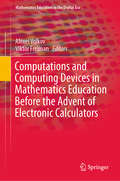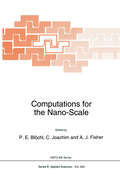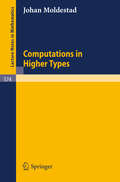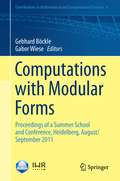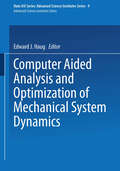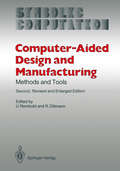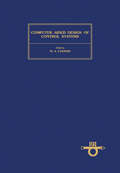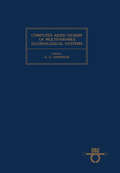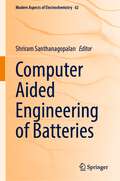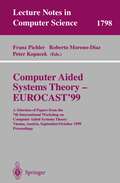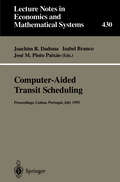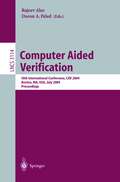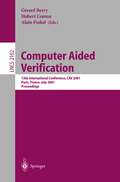- Table View
- List View
Computations and Combinatorics in Commutative Algebra: EACA School, Valladolid 2013 (Lecture Notes in Mathematics #2176)
by Anna M. Bigatti Philippe Gimenez Eduardo Sáenz-de-CabezónFeaturing up-to-date coverage of three topics lying at the intersection of combinatorics and commutative algebra, namely Koszul algebras, primary decompositions and subdivision operations in simplicial complexes, this book has its focus on computations. "Computations and Combinatorics in Commutative Algebra" has been written by experts in both theoretical and computational aspects of these three subjects and is aimed at a broad audience, from experienced researchers who want to have an easy but deep review of the topics covered to postgraduate students who need a quick introduction to the techniques. The computational treatment of the material, including plenty of examples and code, will be useful for a wide range of professionals interested in the connections between commutative algebra and combinatorics.
Computations and Computing Devices in Mathematics Education Before the Advent of Electronic Calculators (Mathematics Education in the Digital Era #11)
by Alexei Volkov Viktor FreimanThis volume traces back the history of interaction between the “computational” or “algorithmic” aspects of elementary mathematics and mathematics education throughout ages. More specifically, the examples of mathematical practices analyzed by the historians of mathematics and mathematics education who authored the chapters in the present collection show that the development (and, in some cases, decline) of counting devices and related computational practices needs to be considered within a particular context to which they arguably belonged, namely, the context of mathematics instruction; in their contributions the authors also explore the role that the instruments played in formation of didactical approaches in various mathematical traditions, stretching from Ancient Mesopotamia to the 20th century Europe and North America.
Computations for the Nano-Scale (NATO Science Series E: #240)
by P. E. Blöchl C. Joachim A. J. FisherProceedings of the NATO Advanced Research Workshop, Aspet, France, October 12-16, 1992
Computations in Algebraic Geometry with Macaulay 2 (Algorithms and Computation in Mathematics #8)
by David Eisenbud Daniel R. Grayson Mike Stillman Bernd SturmfelsThis book presents algorithmic tools for algebraic geometry, with experimental applications. It also introduces Macaulay 2, a computer algebra system supporting research in algebraic geometry, commutative algebra, and their applications. The algorithmic tools presented here are designed to serve readers wishing to bring such tools to bear on their own problems. The first part of the book covers Macaulay 2 using concrete applications; the second emphasizes details of the mathematics.
Computations with Markov Chains: Proceedings of the 2nd International Workshop on the Numerical Solution of Markov Chains
by William J. StewartComputations with Markov Chains presents the edited and reviewed proceedings of the Second International Workshop on the Numerical Solution of Markov Chains, held January 16--18, 1995, in Raleigh, North Carolina. New developments of particular interest include recent work on stability and conditioning, Krylov subspace-based methods for transient solutions, quadratic convergent procedures for matrix geometric problems, further analysis of the GTH algorithm, the arrival of stochastic automata networks at the forefront of modelling stratagems, and more. An authoritative overview of the field for applied probabilists, numerical analysts and systems modelers, including computer scientists and engineers.
Computations with Modular Forms: Proceedings of a Summer School and Conference, Heidelberg, August/September 2011 (Contributions in Mathematical and Computational Sciences #6)
by Gebhard Böckle Gabor WieseThis volume contains original research articles, survey articles and lecture notes related to the Computations with Modular Forms 2011 Summer School and Conference, held at the University of Heidelberg. A key theme of the Conference and Summer School was the interplay between theory, algorithms and experiment.The 14 papers offer readers both, instructional courses on the latest algorithms for computing modular and automorphic forms, as well as original research articles reporting on the latest developments in the field.The three Summer School lectures provide an introduction to modern algorithms together with some theoretical background for computations of and with modular forms, including computing cohomology of arithmetic groups, algebraic automorphic forms, and overconvergent modular symbols.The 11 Conference papers cover a wide range of themes related to computations with modular forms, including lattice methods for algebraic modular forms on classical groups, a generalization of the Maeda conjecture, an efficient algorithm for special values of p-adic Rankin triple product L-functions, arithmetic aspects and experimental data of Bianchi groups, a theoretical study of the real Jacobian of modular curves, results on computing weight one modular forms, and more.
Computed Tomography: From Photon Statistics to Modern Cone-Beam CT
by Thorsten M. BuzugThis volume provides an overview of X-ray technology and the historical development of modern CT systems. The main focus of the book is a detailed derivation of reconstruction algorithms in 2D and modern 3D cone-beam systems. A thorough analysis of CT artifacts and a discussion of practical issues such as dose considerations give further insight into current CT systems. Although written mainly for graduate students, practitioners will also benefit from this book.
Computer Aided Analysis and Optimization of Mechanical System Dynamics (NATO ASI Subseries F: #9)
by E. J. HaugThese proceedings contain lectures presented at the NATO-NSF-ARO sponsored Advanced Study I~stitute on "Computer Aided Analysis and Optimization of Mechanical System Dynamics" held in Iowa City, Iowa, 1-12 August, 1983. Lectures were presented by free world leaders in the field of machine dynamics and optimization. Participants in the Institute were specialists from throughout NATO, many of whom presented contributed papers during the Institute and all of whom participated actively in discussions on technical aspects of the subject. The proceedings are organized into five parts, each addressing a technical aspect of the field of computational methods in dynamic analysis and design of mechanical systems. The introductory paper presented first in the text outlines some of the numerous technical considerations that must be given to organizing effective and efficient computational methods and computer codes to serve engineers in dynamic analysis and design of mechanical systems. Two substantially different approaches to the field are identified in this introduction and are given attention throughout the text. The first and most classical approach uses a minimal set of Lagrangian generalized coordinates to formulate equations of motion with a small number of constraints. The second method uses a maximal set of cartesian coordinates and leads to a large number of differential and algebraic constraint equations of rather simple form. These fundamentally different approaches and associated methods of symbolic computation, numerical integration, and use of computer graphics are addressed throughout the proceedings.
Computer-Aided Analysis of Rigid and Flexible Mechanical Systems (NATO Science Series E: #268)
by Manuel F. O. Seabra Pereira Jorge A. C. AmbrósioThis book contains the edited version of the lectures presented at the NATO ADVANCED STUDY INSTITUTE on "COMPUTER AIDED ANALYSIS OF RIGID AND FLEXIBLE MECHANICAL SYSTEMS". held in Troia. Portugal. from the 27 June to 9 July. 1993. and organized by the Instituto de Engenharia Mecanica. Instituto Superior Tecnico. This ASI addressed the state-of-art in the field of multibody dynamics. which is now a well developed subject with a great variety of formalisms. methods and principles. Ninety five participants. from twenty countries. representing academia. industry. government and research institutions attended this Institute. This contributed greatly to the success of the Institute since it encouraged the interchange of experiences between leading scientists and young scholars and promoted discussions that helped to generate new ideas and to defme directions of research and future developments. The full program of the Institute included also contributed presentations made by participants where different topics have been explored. Such topics include: formulations and numerical aspects in rigid and flexible mechanical systems; object-oriented paradigms; optimal design and synthesis; robotics; kinematics; path planning; control; impact dynamics; and several application oriented developments in weapon systems. vehicles and crash worthiness. These papers have been revised and will be published by Kluwer in a special issue of the Journal of Nonlinear Dynamics and in a forthcoming companion book. This book brings together. in a tutorial and review manner. a comprehensive summary of current work and is therefore suitable for a wide range of interests.
Computer Aided Assessment of Mathematics
by Chris SangwinAssessment is a key driver in mathematics education. This book examines computer aided assessment (CAA) of mathematics in which computer algebra systems (CAS) are used to establish the mathematical properties of expressions provided by students in response to questions. In order to automate such assessment, the relevant criteria must be encoded and, in articulating precisely the desired criteria, the teacher needs to think very carefully about the goals of the task. Hence CAA acts as a vehicle to examine assessment and mathematics education in detail and from a fresh perspective. One example is how it is natural for busy teachers to set only those questions that can be marked by hand in a straightforward way, even though the constraints of paper-based formats restrict what they do and why. There are other kinds of questions, such as those with non-unique correct answers, or where assessing the properties requires the marker themselves to undertake a significant computation. It is simply not sensible for a person to set these to large groups of students when marking by hand. However, such questions have their place and value in provoking thought and learning. This book, aimed at teachers in both schools and universities, explores how, in certain cases, different question types can be automatically assessed. Case studies of existing systems have been included to illustrate this in a concrete and practical way.
Computer-Aided Design and Manufacturing: Methods and Tools (Symbolic Computation)
by U. Rembold R. DillmannManufacturing contributes to over 60 % of the gross national product of the highly industrialized nations of Europe. The advances in mechanization and automation in manufacturing of international competitors are seriously challenging the market position of the European countries in different areas. Thus it becomes necessary to increase significantly the productivity of European industry. This has prompted many governments to support the development of new automation resources. Good engineers are also needed to develop the required automation tools and to apply these to manufacturing. It is the purpose ofthis book to discuss new research results in manufacturing with engineers who face the challenge of building tomor row's factories. Early automation efforts were centered around mechanical gear-and-cam technology and hardwired electrical control circuits. Because of the decreasing life cycle of most new products and the enormous model diversification, factories cannot be automated efficiently any more by these conventional technologies. With the digital computer, its fast calculation speed and large memory capacity, a new tool was created which can substantially improve the productivity of manufactur ing processes. The computer can directly control production and quality assurance functions and adapt itself quickly to changing customer orders and new products.
Computer Aided Design of Control Systems: Proceedings of the IFAC Symposium, Zürich, Switzerland, 29-31 August 1979
by M. A. CuenodComputer Aided Design of Control Systems focuses on the use of computers to analyze and design the control of various processes, as well as the development of program packages with different algorithms for digital computers. The selection first takes a look at the computer aided design of minimal order controllers, including design of interacting and noninteracting dynamic controllers of minimal order and basic algorithm. The book then discusses an accelerated Newton process to solve Riccati equation through matrix sign function; suboptimal direct digital control of a trickle-bed absorption column; and structural design of large systems employing a geometric approach. The text underscores the computer as an aid for the implementation of advanced control algorithms on physical processes and analysis of direct control algorithms and their parallel realization. Topics include hardware influences on the control, process influence, and interactive structure design of direct control systems. The book also takes a look at the optimal control of randomly sampled linear stochastic systems; computer aided design of suboptimal test signals for system identification; and computer aided design of multi-level systems with prescribed structure and control constraints. The selection is a dependable source of data for readers interested in the uses of computers.
Computer Aided Design of Multivariable Technological Systems: Proceedings of the Second IFAC Symposium West Lafayette, Indiana, USA, 15-17 September 1982
by G. G. LeiningerComputer Aided Design of Multivariable Technological Systems covers the proceedings of the Second International Federation of Automatic Control (IFAC). The book reviews papers that discuss topics about the use of Computer Aided Design (CAD) in designing multivariable system, such as theoretical issues, applications, and implementations. The book tackles several topics relevant to the use of CAD in designing multivariable systems. Topics include quasi-classical approach to multivariable feedback system designs; fuzzy control for multivariable systems; root loci with multiple gain parameters; multivariable frequency domain stability criteria; and computational algorithms for pole assignment in linear multivariable systems. The text will be of great use to professionals whose work involves designing and implementing multivariable systems.
Computer Aided Engineering of Batteries (Modern Aspects of Electrochemistry #62)
by Shriram SanthanagopalanThis edited volume, with contributions from the Computer Aided Engineering for Batteries (CAEBAT) program, provides firsthand insights into nuances of implementing battery models in actual geometries. It discusses practical examples and gaps in our understanding, while reviewing in depth the theoretical background and algorithms. Over the last ten years, several world-class academics, automotive original equipment manufacturers (OEMs), battery cell manufacturers and software developers worked together under an effort initiated by the U.S. Department of Energy to develop mature, validated modeling tools to simulate design, performance, safety and life of automotive batteries. Until recently, battery modeling was a niche focus area with a relatively small number of experts. This book opens up the research topic for a broader audience from industry and academia alike. It is a valuable resource for anyone who works on battery engineering but has limited hands-on experience with coding.
Computer-Aided Introduction to Econometrics
by Juan Rodriguez PooThe advent of low cost computation has made many previously intractable econometric models empirically feasible and computational methods are now realized as an integral part of the theory.This book provides graduate students and researchers not only with a sound theoretical introduction to the topic, but allows the reader through an internet based interactive computing method to learn from theory to practice the different techniques discussed in the book. Among the theoretical issues presented are linear regression analysis, univariate time series modelling with some interesting extensions such as ARCH models and dimensionality reduction techniques.The electronic version of the book including all computational possibilites can be viewed athttp://www.xplore-stat.de/ebooks/ebooks.html
Computer Aided Proofs in Analysis (The IMA Volumes in Mathematics and its Applications #28)
by Kenneth R. Meyer Dieter S. SchmidtThis IMA Volume in Mathematics and its Applications COMPUTER AIDED PROOFS IN ANALYSIS is based on the proceedings of an IMA Participating Institutions (PI) Conference held at the University of Cincinnati in April 1989. Each year the 19 Participating Institutions select, through a competitive process, several conferences proposals from the PIs, for partial funding. This conference brought together leading figures in a number of fields who were interested in finding exact answers to problems in analysis through computer methods. We thank Kenneth Meyer and Dieter Schmidt for organizing the meeting and editing the proceedings. A vner Friedman Willard Miller, Jr. PREFACE Since the dawn of the computer revolution the vast majority of scientific compu tation has dealt with finding approximate solutions of equations. However, during this time there has been a small cadre seeking precise solutions of equations and rigorous proofs of mathematical results. For example, number theory and combina torics have a long history of computer-assisted proofs; such methods are now well established in these fields. In analysis the use of computers to obtain exact results has been fragmented into several schools.
Computer Aided Systems Theory – EUROCAST 2005: 10th International Conference on Computer Aided Systems Theory, Las Palmas de Gran Canaria, Spain, February 7-11, 2005, Revised Selected Papers (Lecture Notes in Computer Science #3643)
by Roberto Moreno-Díaz Franz Pichler Alexis Quesada ArencibiaThe concept of CAST, computer aided systems Theory, was introduced by F. Pichler of Linz in the late 1980s to include those computer theoretical and practical developments used as tools to solve problems in system science. It was considered as the third component (the other two being CAD and CAM) that would provide for a complete picture of the path from computer and systems sciences to practical developments in science and engineering. The University of Linz organized the first CAST workshop in April 1988, which demonstrated the acceptance of the concepts by the scientific and technical community. Next, the University of Las Palmas de Gran Canaria joined the University of Linz to organize the first international meeting on CAST (Las Palmas February 1989), under the name EUROCAST 1989, a very successful gathering of systems theorists, computer scientists and engineers from most European countries, North America and Japan. It was agreed that EUROCAST international conferences would be organized every two years. Thus, the following EUROCAST meetings took place in Krems (1991), Las Palmas (1993), Innsbruck (1995), Las Palmas (1997), Vienna (1999), Las Palmas (2001) and Las Palmas (2003) in addition to an extra-European CAST conference in Ottawa in 1994. Selected papers from those meetings were published as Springer Lecture Notes in Computer Science vols. 410, 585, 763, 1030, 1333, 1728, 2178 and 2809 and in several special issues of Cybernetics and Systems: an lnternational Journal.
Computer Aided Systems Theory - EUROCAST 2001: A Selection of Papers from the 8th International Workshop on Computer Aided Systems Theory, Las Palmas de Gran Canaria, Spain, February 19-23, 2001. Revised Papers (Lecture Notes in Computer Science #2178)
by Roberto Moreno-Diaz Bruno Buchberger Jose-Luis FreireThe concept of CAST as Computer Aided Systems Theory, was introduced by F. Pichler in the late 1980s to include those computer theoretical and practical developments as tools to solve problems in System Science. It was considered as the third component (the other two being CAD and CAM) necessary to build the path from Computer and Systems Sciences to practical developments in Science and Engineering. The University of Linz organized the first CAST workshop in April 1988, which demonstrated the acceptance of the concepts by the scientific and technical community. Next, the University of Las Palmas de Gran Canaria joined the University of Linz to organize the first international meeting on CAST, (Las Palmas, February 1989), under the name EUROCAST’89. This was a very successful gathering of systems theorists, computer scientists, and engineers from most European countries, North America, and Japan. It was agreed that EUROCAST international conferences would be organized every two years, alternating between Las Palmas de Gran Canaria and a continental European location. Thus, successive EUROCAST meetings have taken place in Krems (1991), Las Palmas (1993), Innsbruck (1995), Las Palmas (1997), and Vienna (1999), in addition to an extra-European CAST Conference in Ottawa in 1994.
Computer Aided Systems Theory - EUROCAST 2003: 9th International Workshop on Computer Aided Systems Theory, Las Palmas de Gran Canaria, Spain, February 24-28, 2003, Revised Selected Papers (Lecture Notes in Computer Science #2809)
by Robeto Moreno Diaz Franz PichlerThe concept of CAST as Computer Aided Systems Theory, was introduced by F. Pichler of Linz in the late 80’s to include those computer theoretical and practical developments as tools to solve problems in System Science. It was considered as the third component (the other two being CAD and CAM) that will provide for a complete picture of the path from Computer and Systems Sciences to practical developments in Science and Engineering. The University of Linz organized the ?rst CAST workshop in April 1988, which demonstrated the acceptance of the concepts by the scienti?c and technical community. Next, the University of Las Palmas de Gran Canaria joined the University of Linz to organize the ?rst international meeting on CAST, (Las Palmas February 1989), under the name EUROCAST’89, that was a very successful gathering of systems theorists, computer scientists and engineers from most of European countries, North America and Japan. ItwasagreedthatEUROCASTinternationalconferenceswouldbeorganized every two years. Thus, the following EUROCAST meetings took place in Krems (1991), Las Palmas (1993), Innsbruck (1995), Las Palmas (1997), Vienna (1999) and Las Palmas(2001), in addition to an extra-European CAST Conference in Ottawain1994.SelectedpapersfromthosemeetingswerepublishedbySpringer- Verlag Lecture Notes in Computer Science nos. 410, 585, 763, 1030, 1333, 1728 and 2178 and in several special issues of Cybernetics and Systems: an lnternat- nal Journal. EUROCAST and CAST meetings are de?nitely consolidated, as it is demonstrated by the number and quality of the contributions over the years.
Computer Aided Systems Theory - EUROCAST'99: A Selection of Papers from the 7th International Workshop on Computer Aided Systems Theory Vienna, Austria, September 29 - October 2, 1999 Proceedings (Lecture Notes in Computer Science #1798)
by Franz Pichler Roberto Moreno-Diaz Peter KopacekComputer Aided Systems Theory (CAST) deals with the task of contributing to the creation and implementation of tools for the support of usual CAD tools for design and simulation by formal mathematical or logical means in modeling. Naturally,thebasisfortheconstructionandimplementationofCASTsoftwareis provided by the existing current knowledge in modeling and by the experience of practitioners in engineering design. Systems Theory, as seen from the viewpoint of CAST research and CAST tool development, has the role of providing formal frameworks and related theoretical knowledge for model-construction and model analysis. We purposely do not distinguish sharply between systems theory and CAST and other similar ?elds of research and tool development such as for example in applied numerical analysis or other computational sciences. TheheredocumentedEUROCASTconferencewhichtookplaceattheVienna University of Technology re?ects current mainstreams in CAST. As in the p- vious conferences new topics, both theoretical and application oriented, have been addressed. The presented papers show that the ?eld is widespread and that new - velopments in computer science and in information technology are the driving forces. Theeditorswouldliketothanktheauthorsforprovidingtheirmanuscriptsin hardcopyandinelectronicformontime.Thesta?ofSpringer-VerlagHeidelberg gave, as in previous CAST publications, valuable support in editing this volume.
Computer-Aided Transit Scheduling: Proceedings of the Sixth International Workshop on Computer-Aided Scheduling of Public Transport (Lecture Notes in Economics and Mathematical Systems #430)
by Joachim R. Daduna Isabel Branco Jose M. P. PaixaoThis proceedings volume consists of papers presented at the Sixth International Workshop on Computer-Aided Scheduling of Public Transpon, which was held at the Fund~lio Calouste Gulbenkian in Lisbon from July 6th to 9th, 1993. In the tradition of alternating Workshops between North America and Europe - Chicago (1975), Leeds (1980), Montreal (1983), Hamburg (1987) and again Montreal (1990), the European city of Lisbon was selected as the venue for the Workshop in 1993. As in earlier Workshops, the central theme dealt with vehicle and duty scheduling problems and the employment of operations-research-based software systems for operational planning in public transport. However, as was initiated in Hamburg in 1987, the scope of this Workshop was broadened to include topics in related fields. This fundamental alteration was an inevitable consequence of the growing demand over the last decade for solutions to the complete planning process in public transport through integrated systems. Therefore, the program of this workshop included sections which dealt with scheduling problems and computerized systems for operational planning as well as sections on network planning and data management.
Computer Aided Verification: 16th International Conference, CAV 2004, Boston, MA, USA, July 13-17, 2004, Proceedings (Lecture Notes in Computer Science #3114)
by Rajeev Alur Doron A. PeledComputer Aided Verification: 18th International Conference, CAV 2006, Seattle, WA, USA, August 17-20, 2006, Proceedings (Lecture Notes in Computer Science #4144)
by Thomas Ball Robert B. JonesThis book constitutes the refereed proceedings of the 18th International Conference on Computer Aided Verification, CAV 2006, held as part of the 4th Federated Logic Conference, FLoC 2006. Presents 35 revised full papers together with 10 tool papers and 4 invited papers adressing all current issues in computer aided verification and model checking - from foundational and methodological issues ranging to the evaluation of major tools and systems

